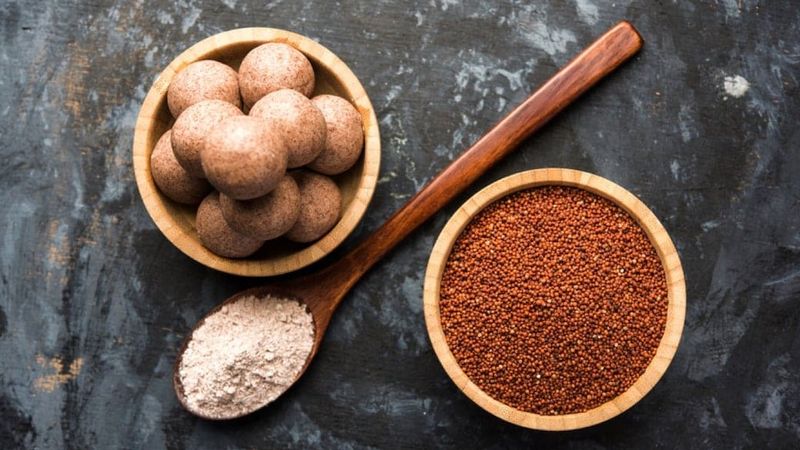

Our Review Process
Our articles undergo extensive medical review by board-certified practitioners to confirm that all factual inferences with respect to medical conditions, symptoms, treatments, and protocols are legitimate, canonical, and adhere to current guidelines and the latest discoveries. Read more.
Our Editorial Team
Shifa Fatima, MSc.
Author
Dr. Apoorva T, MHM.
MEDICAL ADVISOR
Ragi Good for Diabetes
Ragi or finger millets had been grown in tropical regions for thousands of years. Millions of people have been using them in their foods. They have become part of human food.
Ragi is the millet that is grown throughout the year due to its drought-tolerant property. It is packed with nutrients that have proved to be beneficial for the health of the person if consumed in the right quantity. Is ragi good for diabetes? Can it help people with diabetes to regulate their diabetes? Can diabetic patients eat ragi? Let’s take a look.
Table of Contents
Ragi Glycemic Index
Ragi has a glycemic index (GI) score that ranges between 54 and 68. The amount of glycemic index you get from ragi depends on whether you use it whole grain or in atta form.
Ragi Nutrition Facts
Ragi is packed with essential nutrients as compared to other millets. It is even a healthy option and an alternative to other routine cereal and grain crops like rice and wheat because of its richness in nutrients. It is high in calcium, iron, essential amino acids, dietary fibre, high-quality protein, vitamin A, vitamin B complex and phosphorus. Due to its richness of calcium, it is great for bone health.
It also comprises phenolic compounds and phytochemicals which are helpful to carry out high antioxidant activities in the body. It has zero cholesterol which makes it a great diet option for people with heart ailments and also supports weight loss.
The following chart shows the nutritional value of ragi per 100 gm of serving -
| Nutrition | Value |
|---|---|
| Energy | 336 kcal |
| Protein | 7.7 gm |
| Fat | 1.5 gm |
| Fibre | 11.5 gm |
| Carbohydrate | 72.6 gm |
| Calcium | 350 mg |
| Iron | 3.9 mg |
| Magnesium | 137 mg |
| Phosphorus | 283 mg |
| Manganese | 5.94 mg |
| Potassium | 408 mg |
Types of Ragi
Ragi has been in existence for thousands of years. It has always been the primary source of nutrition for tons of people all over the world. It is a superfood for all categories of people which includes children, pregnant women, and elderly people as it is packed with some of the amazing nutrients that are essential for our bodies like calcium, phytochemicals and phenolic compounds. As the ragi glycemic index is low and it is rich in fibre, amino acids and minerals, it is a boon for people with diabetes and heart ailments. It is also helpful for people who are struggling with obesity and various metabolic diseases.
Ragi is basically cultivated in dry and hot climatic conditions and is also grown in places of high altitudes. There are various types of ragi available depending on the size of the ragi which generally varies from 1 mm to 2 mm in diameter. Ragi is also found in different colours ranging from brown to white and red to black. Also read about best grains for diabetes.

Is Ragi good for Diabetics?
Ragi is useful for both type 1 diabetes and type 2 diabetes. Ragi is a rich source of fibres that are useful to keep you fuller for a long time. Here is a list of fiber rich foods for diabetes. Patients with diabetes have the problem of hunger, which can be easily solved by ragi since it is a good source of fibre. It has low-glycemic that helps in preventing spikes in blood sugar levels .Consuming ragi about 50-60% from 15-20% total carb consumption is recommended for people with diabetes. This can help to keep their diabetes at bay.
Inflammation
It is caused when our body sends the inflammatory cells and cytokinins to fight against the harmful foreign particles entering our body. It is normal to have inflammation, but if it stays for a long time, then it may be a problem. In the case of diabetes, the inflammation is internal, which has been occurring in our body for a long time. Internal inflammation occurs due to obesity.
It is observed that the level of the inflammatory chemical is more in people with diabetes compared to people without diabetes. Oxidative stress is also one of the factors that may lead to diabetes. In this condition, the body is not able to balance free radicals and antioxidants. So, is ragi good for diabetes to overcome the above factors? The answer is yes. Ragi can be used to reduce your weight, which is the prime cause of inflammation. Also, it has antioxidants and anti-inflammatory properties. Also know about how to reduce sugar.
Blood sugar levels
- Finger millet has carbohydrates and calories in high amounts for instant energy. Still, it also has a plethora of phytates, tannins, polyphenols which are useful to slow down the digestion process. This reduce sugar level in the patient with diabetes mellitus.
- Polyphenols are the micronutrients present in plant-based products. They are found to have various health benefits, including one of the benefits for diabetes patients since they have a high concentration of antioxidants.
- Increases in the level of albumin (protein in the human body) in urine and creatinine in the blood indicate complexion in people with diabetes.
- Research with a diabetic rat that was given finger millets seeds for 6 weeks has shown a reduction in the albumin and creatinine secretion of blood and urine, respectively. Studies on humans have to be done, which can confirm that ragi can be helpful to control these levels.
- Being higher in fibres (helps to stabilize sugar), ragi tends to have less impact on the blood sugar level of people with diabetes compared to other millets. Eating ragi even when you don't have diabetes will help you to prevent it because precaution is better than cure!
Also read about glucose in urine
Ragi Benefits
Ragi is a wonder food which is immensely packed with nutrients and so offers a lot of health benefits to all those who consume it. There are various ways and different recipes out there which make it easier for everyone to include ragi in their daily diet plan. Ragi is multifunctional and is filled with amazing properties such as anti-diabetic, anti-inflammatory, anti-diarrhoeal, anti-ulcer, anti-microbial, antioxidant and anti-tumorigenic properties.
The following are some of the health benefits that ragi offers to all those who make it a part of their diet plan –
Ragi has Anti-diabetic Properties
Ragi benefits for diabetes are more as it is rich in phenolic extracts which help manage hyperglycemic conditions. It helps reduce the spike in blood sugar levels. The ragi glycemic index is comparatively low as compared to other cereals and grains and the presence of dietary fiber in ragi maintains the digestive pace and keeps you fuller for a long time. This in turn keeps the mid-meals cravings at bay subsequently keeping the blood sugar levels in control.
It is Gluten-free
Gluten is an element that usually leads to allergies and indigestion problems. Ragi is gluten-free and so it is great for people who are gluten intolerant. It can be substituted for wheat and various dishes like chapatis, dosas etc can be prepared using ragi. Ragi flour for diabetes instead of wheat flour is highly recommended for people with type 1 and type 2 diabetes. Also know about sugar free biscuits.
Possess High Dietary Fiber
As ragi is rich in dietary fibre, it helps in preventing gastrointestinal disorders, coronary heart diseases, colon cancer and diabetes. Ragi also prevents constipation as the fibre present in it acts as a laxative that stimulates bowel motility. Also, the fibre increases the satiety level preventing hunger pangs thereby contributing to weight loss.
It Contains Calcium
Ragi has a high calcium content and so is good for growing children to strengthen their bones and make them strong. Even in older people, it helps in restoring the optimum bone density alleviating the symptoms of osteoporosis.
Rich in Vitamin D
Ragi is one of the few sources of vitamin D apart from the sunlight and is good for bones as well as the skin. It helps in regulating calcium and phosphate which are responsible to keep the teeth, bones and muscles healthy.
Prevents Cancer
Ragi is filled with phytochemicals and antioxidants which have extensive anti-carcinogenic properties and help in the prevention of cancer. It contains ferulic acid which has wonderful blocking effects to induced carcinogenesis, thereby preventing cancer.
Treats Anemia
Ragi is known to be the powerhouse of iron and therefore, it serves as a boon for people who are anaemic by increasing the haemoglobin level in the blood.
Reduces Heart Ailments
Ragi has zero cholesterol and is also devoid of sodium. This is, therefore, highly recommended for people with heart ailments. Due to the presence of vitamin B3 and niacin, it helps increase good cholesterol and reduce bad cholesterol levels. This enhances cardiac muscle function and improves heart health.
Ragi has antioxidant properties and can inhibit collagen crosslinking that help in reducing the stiffness of elastic tissues in blood vessels, tendon and skin thereby delaying the ageing process.
Health Benefits of Ragi for diabetes
Ragi for diabetes can be one of the most helpful and useful benefits. Finger millet can keep sugar levels in check and provides instant energy. It has a lot of plant chemicals like – phytates, tannins, polyphenols, etc that slow down the digestion process. This can reduce the spike in blood sugars and the body can process the food at a good pace. Ragi is a valuable addition to the diet chart of a person with type 1 and type 2 diabetes. The fiber-rich properties can ensure that the person feels full after consumption and can result in the stoppage of unnecessary hunger pangs. It can also accelerate weight loss and can help with diabetes and obesity.
How to eat ragi?
Nowadays you can see there are various products like biscuits, cake are available in the market, bakeries which are labelled has made of ragi. Pick any which you like. You can make the laddoos of the ragi or even the ragi malt. In Maharashtra, Bhakri is made from ragi flour. People in Karnataka make the mudde of ragi. The best way to consume the ragi is by soaking them in the water and then boiling them to make the porridge. Ragi idli, ragi dosa, ragi vada, ragi pudding, ice cream of ragi, ragi poli, papad of ragi are some of the dishes which you will enjoy eating.
Understanding sugar free, No Added Sugar,and Unsweetened
Bottomline
Ragi is the best millet to regulate diabetes. The proteins, minerals, calcium, potassium, magnesium, antioxidants, and inflammatory properties it possesses vitamins not just make it good for people with diabetes but also useful for people suffering from vitamin deficiency, obesity, bone problems, and many more. The consumption of ragi is more helpful in the case of type-2 diabetes since it has anti-inflammatory and antioxidant properties. So, now don’t ask, ‘Is ragi good for diabetes?' instead, start consuming it!
FAQs
Is ragi good for diabetes?
Yes, Ragi is good for diabetes as it is rich in fibre, minerals, and amino acids. Ragi is a great substitute for white rice and wheat because it helps in maintaining blood sugar and cholesterol levels stable.
Is ragi good for weight loss?
There can be several ragi benefits for weight loss. The primary reason for this is that ragi contains an amino acid called – tryptophan which is associated with the curbing of one’s appetite. If you will not eat more, you will not end up gaining a lot of weight. Moreover, among the other benefits of eating ragi is that it is rich in fiber, which would help in effective digestion and would make you feel full for a long time. This will also work towards a lower appetite. Another reason why ragi can be a good addition to the diet, especially if the goal is to lose weight would be that it boosts the metabolism.
Does ragi increase blood sugar?
To understand, is ragi good for diabetes would have to be associated with how much the blood sugar levels of the body would spike upon the consumption of ragi. Due to the fiber-rich factor, this grain would not affect blood sugars as much as other refined grains. It is also said that the intake of ragi, even every day, would help in stabilizing the blood sugar levels. The grain also works to prevent the onset of type 2 diabetes. Among the other benefits of ragi is that it also keeps cholesterol levels in check.
What's the Glycemic Index of ragi?
The glycemic index of ragi ranges from 54 to 68. This puts it at a slightly higher level. However, the amount of fiber present in the grain makes it a good contender for slower absorption and digestion of food. This would create a slower uptake of sugar and glucose molecules in the body resulting in no spikes in the blood sugar level.
Is Ragi flour good for diabetes?
Yes, ragi flour is good for diabetes as it helps in maintaining blood sugar levels and cholesterol levels. The presence of fibre in ragi delays the absorption of glucose in the blood and the low glycemic index in ragi helps in reducing the chances of spiking blood sugar levels.
Is millet good for diabetes?
Yes, millet is good for diabetes as it is lower on the glycemic index which gradually increases the blood sugar instead of a sudden spike in the blood sugar levels. Millets are generally high in fibre and low in cholesterol and that’s why they are a great option for people with diabetes.
What is the ragi flour glycemic index?
The glycemic index of ragi is somewhere between 54 to 68 which is actually in the range of the medium glycemic index category. This means that ragi can be taken in controlled quantities for diabetes. However, upon cooking the glycemic index comes down to 55 which is low and so it is safe for people with diabetes.
References
- https://www.healthline.com/nutrition/ragi-good-for-diabetes
Disclaimer
This website's content is provided only for educational reasons and is not meant to be a replacement for professional medical advice. Due to individual differences, the reader should contact their physician to decide whether the material is applicable to their case.








